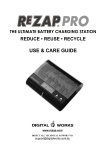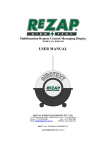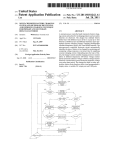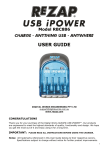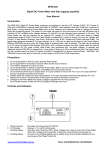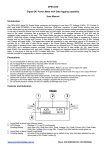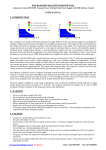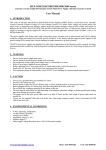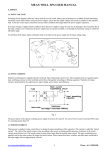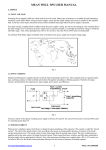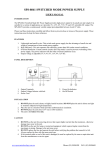Download Digital Works ReZap Pro RBC889 Use & care guide
Transcript
USE & CARE GUIDE www.procontechnology.com.au Phone: (03) 98306288 FAX: (03) 98306481 DIGITAL WORKS ENGINEERING PTY. LTD. 117 SPRINGVALE ROAD, SPRINGVALE, VIC. 3171 AUSTRALIA P.O. BOX 728, CAMBERWELL SOUTH, VIC. 3124, AUSTRALIA Phone: + 61 3 9558 5880 Fax: + 61 3 9558 5889 Email: [email protected] DIRECT ALL TECHNICAL SUPPORT TO: [email protected] Notes: All trademarks referenced in this User Guide belong to their respective owners. Specifications subject to change without notice for further product improvements. www.procontechnology.com.au Phone: (03) 98306288 FAX: (03) 98306481 CONGRATULATIONS Thank you for your purchase of the ReZAP® Battery Doctor battery charger. Our products are engineered to meet the highest standards of quality, functionality and design. We hope you get the most out of it and enjoy using it for many years to come. Please read all the information contained in this booklet before using the charger. It gives you important instructions on safety, use, and maintenance of the appliance. Please keep these instructions in a safe place and pass them on, if necessary, to the next owner. WARNING – SAFETY PRECAUTIONS • Risk of electric shock. Dry location use only. This charger is for indoor use only and should only be connected to the same mains voltage as shown on the rating plate. • Do not operate the charger with a damaged cord or if the housing shows visible signs of damage. • Charge only 1 to 4 pieces of AAAA, AAA, AA, C, D, N, 9V, 6V dolphin/lantern size batteries of type Alkaline, Titanium, Rechargeable Alkaline Manganese (RAM), Nickel Cadmium (NiCd) or Nickel Metal Hydride (NiMH) only. Other type such as Carbon Zinc or Lithium may explode or burst causing personal injury and damage. • DO NOT attempt to charge any battery that has sign of rust, chemical leakage or deposit on the terminals. • Batteries rejected by the charger or those with very short service life after recharged should be disposed of promptly to avoid leakage causing damage to the charger and or electronic devices. • The charger is not intended for use by young children or infirm persons without supervision. • Keep clear cover of charger closed at all times during charging. www.procontechnology.com.au Phone: (03) 98306288 FAX: (03) 98306481 SH IMPORTANT • Do not remove any service covers from the charger. There are no user serviceable parts inside. Any repair should be carried out by a trained technician at Digital Works service centre or at an appointed service outlet. The device must not be subjected to humidity, heat sources or wet conditions. • If the charger is wrongly operated for a purpose other than that for which it is intended as per the instructions set out in this guide, no liability can be accepted for any possible damage. • Turn the power off and remove the plug when the charger is not in use and before cleaning. • If your charger has a fault, please contact your retailer, local distributor or directly to Digital Works service centre. KEY FEATURES OF REZAP® BATTERY DOCTOR • Advanced microprocessor control for safe and user-friendly operation. • Supports most domestic size batteries including AAAA, AAA, AA, C, D, N, 9V, 6V dolphin/lantern and prismatic sizes (Prismatic batteries are of gum-stick shape, 1.2V rechargeable and often used in Walkman, Discman or MD players). • Supports Alkaline, Titanium, RAM (Rechargeable Alkaline Manganese), NiCd (Nickel Cadmium) and NiMH (Nickel Metal Hydride) batteries. • Automatically detects different sizes and types of batteries. • Individual charging feature supports up to four mixed sizes and types of batteries simultaneously. • Extends 9V and 6V dolphin/lantern battery life up to 5* times. • Extends Alkaline and Titanium battery lives up to 10* times. • Recharge RAM batteries up to 25* times. • Recharge NiCd and NiMH rechargeable batteries hundreds of times. • Overcharging protection prevents damage to batteries. • Built-in battery test function to measure the strength of each battery. www.procontechnology.com.au Phone: (03) 98306288 FAX: (03) 98306481 NGLISH • The charger must be stored where weather conditions cannot affect it. • Simple plug-and-play operation with no confusing and complicated switch settings. • Australian engineering and technology. * The Cycle life of batteries depends strongly on factors such as brand, quality and conditions of batteries as well as rate of discharge, cut-off voltage and depth of discharge of batteries. Depth of discharge is defined as the level to which battery Discharging to less than the recommended voltage is known as over-discharge. The shallower the discharge, the more cycles the battery will provide. This is true for all battery chemistries. SAFETY FEATURES REZAP® Battery Doctor RBC883 has been designed to meet the highest safety standards. A combination of hardware and software controls has been employed to deliver the following multi protection schemes: • Alkaline battery charge-safe protection, • Faulty battery detection & rejection, • Overcharge protection, • Short circuit protection, • Wrong polarity Protection, • Negative Delta Voltage protection, • Zero Delta Voltage protection, • Temperature Protection, • Timer Protection, The REZAP® Battery Doctor complies with the following International Standards for electrical safety: • AS/NZS 3108:1994; AS/NZS 3350.1:2000; AS/NZS 3350.2.29:2001 • EN 206041A; EN 60335.1; EN 60335.2.29 • EMC & C-Tick (AS/NZS 1044:1995); CE (EN50082-1) • FCC Part 15 Class B - ANSI C63.4-1992 • UL 1310 – Fourth Edition – Class 2 Power Units • CSA Standard C22.2 No. CAN/CSA-223-M91; • CSA Informs – Power Supplies No. 3 • CSA Technical Information Letter No. Q-13 (Battery Charger for Charging Alkaline Batteries) www.procontechnology.com.au Phone: (03) 98306288 FAX: (03) 98306481 NGLISH voltage is taken during discharge. QUICK START STEP 1: TURNING THE CHARGER ON • Plug the charger into a proper indoor electrical outlet and turn on the power, the red LED lights up indicating the charger is active and ready for use. STEP 2: CONNECTING THE BATTERIES TO THE CHARGER • Ensure that batteries are in good condition before charging them. DO NOT attempt to charge any battery that has sign of rust, chemical leakage or deposit on the terminals. These should be disposed of immediately to avoid subsequent damage to charger and/or electronic appliances. o Although battery leakage found on some faulty/damaged/old batteries will typically not cause immediate damage to unprotected skin, it is best to avoid contact, or if contact occurs, immediately wash the exposed area with soap and running water. • Place used batteries to be charged into the charger slots according to their different sizes as follows and ensure all batteries are connected correctly to the charger. Pay attention to battery polarities. o AAAA, AAA, AA, C, D, N and prismatic size (1.2V or 1.5V) batteries can be inserted into any of the four main slots. o 9V battery should only be plugged into the 9V terminals provided (the far left slot). o 6V dolphin/lantern battery should be connected to the charger via the pair of cable clips provided, which can be extended out from the base storage compartment. Please ensure that the RED clip is connected to the POSITIVE (+) terminal of the battery and the BLACK clip is connected to the NEGATIVE (-) terminal of the battery. If wrongly connected, our built-in reverse protection circuitry will activate and the charge current will be cut out. (GREEN light does not flash). www.procontechnology.com.au Phone: (03) 98306288 FAX: (03) 98306481 NGLISH • Extend the power cable stored in the base compartment. STEP 3: OBSERVING THE CHARGERS STATUS. • Once batteries are firmly in contact with the chargers metal plates, the charger’s indicator lights will be activated immediately, showing the different charger status as follows: o RED LIGHT ON – Power is ON and the charger is ready for use. o GREEN LIGHT FLASHING – Battery is being charged. o GREEN LIGHT ON – Charging is finished and battery is ready for use. o GREEN LIGHT OFF – Faulty or No battery present or improper battery connection. o GREEN LIGHT TURNS OFF AFTER FLASHING – Battery is faulty, exhausted and or is no longer rechargeable. Prompt dispose of these batteries should occur to avoid eventual battery leakage. IMPORTANT NOTES WHEN USING THE REZAP® CHARGER: • Charge only Alkaline, Titanium, RAM (Rechargeable Alkaline Manganese), NiCd and NiMH batteries. DO NOT charge Carbon Zinc (such as those with no battery type printed on them or those labelled as SUPER HEAVY DUTY or GENERAL PURPOSE) or Lithium batteries (such as those used in cameras, 3V or 6V and labelled – LITHIUM) in this charger (Refer to Table 1 for details of various different battery types and how to recognize them). • Charge alkaline cells before they go completely flat. If the cells are discharged beyond the point of return (less than 0.9V), chances are that they will not be revived properly. Most electronic devices cut off at the 0.9 volt level; however devices such as torches, radios, clocks, remote controls and the like, have completely. a tendency to drain the batteries • Alkaline cells should be disposed of promptly if they are rejected by the charger (green light turns off after flashing) or their service life is very short after recharge. www.procontechnology.com.au Phone: (03) 98306288 FAX: (03) 98306481 NGLISH • • After batteries are charged, test them individually in the battery tester slot before use. Only batteries that show the same voltage strength should be used together. For alkaline batteries, use those that show 3 to 4 Green lights together and for rechargeable batteries, use those that show 3 powering up at all. Also remember not to mix different battery types together (eg: Different brands or alkaline with rechargeable). • For best results, charged alkaline cells should be promptly removed within a few hours after charging is completed. Continuous connection to the metal plates (whether the charger is ON or OFF) for a prolonged period will shorten battery life. Recharged alkaline cells should be used as soon as possible as they are not suitable for long term storage due to their rapid self discharge. • Different brands of alkaline cells may give different results, depending on the chemical composition used in making the product. Do not be surprised to find that some top brand alkaline cells may yield lower cycle life than less well-known brands. Try different brands of batteries and decide for yourself which brands work best in your applications and in the REZAP charger. • The charger has four main slots with four corresponding green lights. Only put one battery per slot. Do not try to put one battery on top of another in a single slot. • Please do not connect the 6V cable clips to any other types of batteries except 6V dolphin/lantern batteries as recommended. • The 9V and 6V batteries occupy the first and forth slots respectively. When a 9V or a 6V battery is being charged, do not place another battery in the first (far left) or the forth (far right) slot as they may conflict with one another. • When charging 9V or 6V batteries, leave batteries in the charger for an additional 2 to 3 hours after the green light appears, to absorb additional trickle charge power. www.procontechnology.com.au Phone: (03) 98306288 FAX: (03) 98306481 NGLISH Green lights together. Mixing weak or partially charged with fully charged batteries will result in your device not functioning properly or not 9V and 6V dolphin/lantern alkaline batteries are not charged using the “individual cell” technique due to their internal structure (multiple cells linked together in series to give a higher battery voltage). Any fault or weakness amongst the cells can result in the battery being poorly • Each slot has 3 battery contact position, bottom, middle and upper. For best results, high capacity (over 2200mAh) NiMH AA batteries should be recharged on the upper contact position. AA to C and D size battery converters are provided for this purpose. • Maximum NiCd/NiMH battery capacity supported in this charger is 4000mAh (for C & D sizes). Those with capacities above this limit are outside the scope of this charger and should not be recharged in this unit as overload may happen, causing damage to the charger. A specialized charger is required to handle them and should be available at the place here these batteries are sold. • Cycle life is based on the battery receiving proper care and also depends on the depth of discharge. In general, shallow discharges provide more cycles than deep discharges. www.procontechnology.com.au Phone: (03) 98306288 FAX: (03) 98306481 NGLISH recharged or not useable at times. Do not expect too much from these batteries. TESTER FUNCTION The charger has a built-in battery tester, which measures voltage level of batteries, one at a time, and displays their strength using the 4 green lights. When a battery, to be tested, is placed into the tester slot with the rest of the remaining slots being empty, the voltage level of the battery is displayed for horizontally from left to right indicating the following conditions: o No Green light - battery is dead or voltage is extremely low. o 1 x Green light - Very Low strength voltage, o 2 x Green lights - Low strength voltage, o 3 x Green lights - Medium strength voltage, o 4 x Green lights - High strength voltage. NOTES • The tester shows only maximum 3 Green lights for rechargeable batteries when “full” as their voltage rating is 1.2V instead of 1.5V of alkaline batteries. • Some exhausted and or faulty alkaline batteries show a false voltage of up to 1.5V or higher when measured by means of a volt meter or the built-in tester, however when you put these to use, they quickly die. These batteries should also be disposed of immediately to avoid eventual battery leakage. CLEANING Turn the power off and remove the plug before cleaning the charger. • The Plastic Body can be cleaned with a lightly damp cloth and then wiped dry with a soft cloth. Do not use any abrasive clothes or solvents on any plastic surface. • The battery compartment contacts can be cleaned using a piece of cloth dampened with Methylated Spirits solvent (available from most hardware stores). Alternatively a clean pencil eraser can be utilised to rub off any dirt and or deposit that might adhere to them. www.procontechnology.com.au Phone: (03) 98306288 FAX: (03) 98306481 H S I L G N E NGLISH about five seconds and if the battery is not removed from the tester slot, automatic charging will proceed. In tester mode, the 4 x Green lights move EXTENDING BATTERY LIFE • Keep extra batteries around for your convenience. Store batteries in a dry place at normal room temperature. • When storing batteries, remove any load or short circuit from their terminals. And ensure that short circuits cannot occur during storage or shipping. • When storing battery-powered devices for long periods (i.e. more than a month), remove the batteries. This can prevent damage to the device from possible battery leakage. Also, the batteries can be used for other applications while the batteries are still "fresh." Batteries should also be removed from equipment while it is being powered by household (AC) current. • When using single-cell rechargeable NiCd batteries, be sure to discharge the cell completely before recharging it, thus counteracting the "memory" effect. • Do not use batteries in high-temperature situations (unless the battery is designed for that temperature range). Store batteries as far away from heat sources as possible. The electrical potential of the battery will degrade rapidly if it is exposed to temperatures higher than those recommended by the manufacturer. • Follow instructions on your equipment regarding proper insertion of batteries, making sure that the (+) and (-) terminals are aligned correctly. • Remove dead batteries from equipment immediately to prevent possible damage from battery leakage. Always replace all batteries at the same time. Mixing old and new batteries or mixing types (such as alkaline with Carbon Zinc) will reduce overall performance and could cause leakage or rupture. www.procontechnology.com.au Phone: (03) 98306288 FAX: (03) 98306481 GENERAL BATTERY SAFETY TIPS • Do not short-circuit a battery. A short-circuit may cause severe damage to the battery. • Do not incinerate, expose the battery to moisture, rain or sources of extreme heat. • Do not dispose of batteries in a fire. The metallic components of the battery will not burn and the burning electrolyte may splatter, explode, or release toxic fumes. • Do not store batteries loosely or carry them loose in your pocket or purse. They can be shorted by contact with metal objects and leak or rupture. • Do not let young children play with batteries, especially button and or 9V cells; these could accidentally be swallowed or licked at and may result in burns that may range from simply uncomfortable to serious. • Do not allow direct body contact with battery chemicals. Acidic or alkaline electrolyte can cause skin irritation or burns. If acidic or alkaline electrolyte contacts skin or clothing, wash immediately with soap and water. If it enters the eye, immediately flood the eye with cold running water for at least fifteen (15) minutes and seek medical help immediately. WARRANTY & SUPPORT The REZAP® charger is supplied with a 12 month parts and labour, return to base, warranty. We will repair or replace the product at our option if defective in workmanship or material from normal domestic use for one year from date of purchase. Any customer feedback and/or support queries should be directed to: [email protected] www.procontechnology.com.au Phone: (03) 98306288 FAX: (03) 98306481 H S I L G N E NGLISH • Do not drop, hit or otherwise abuse the battery as this may result in the exposure of the cell contents, which are corrosive. TROUBLE SHOOTING – Q&A This section contains a list of some of the possible problems that you may encounter with your REZAP® charger unit. • Check to ensure that the detachable power cable (located inside the base storage compartment) is securely connected to the charger and properly plugged into the mains and the switch is turned on. If there’s still no power to the charger, change to a different power outlet and check again. Should the problem persist, return the unit to an authorized repair outlet, place of purchase or directly to Digital Works. 2. The green lights on the charger blink when no batteries are present. • Interference from excessive noise level coming from the AC mains and/or residual settings from the previous charge session have not been all cleared. Turn off the power to the charger, wait for a couple of minutes and turn it back on. Should the problem persist, return the unit to an authorized repair outlet. 3. While charging a rechargeable battery, the green light turns off and charging stops. • Rechargeable batteries of poor quality and or condition do at times display similar characteristics as those of bad or faulty alkaline batteries and consequently get rejected by the ReZAP for safety reasons. When the green light turns off at the end of the charging process (at least several hours) for a rechargeable battery, it can be removed and used normally. If in doubt, test the battery in the tester slot to see if it indicates 3 green lights. 4. Ordinary alkaline batteries that appear to be 3/4 charged (3 green lights) take a charge for a short time then the light goes out. • Every time an alkaline battery is put into the unit, the charger applies a series of test patterns to the battery and if its voltage exceeds a certain threshold value (indicates a poor condition battery) which the charger considers as unsafe to continue, the slot will be switched off for safety reasons. www.procontechnology.com.au Phone: (03) 98306288 FAX: (03) 98306481 NGLISH 1. The Charger does not work - no power. 5. The green light does not turn on or blink even when there is a battery in the slot. relocating the battery to a different slot to ensure problem is not caused by the slot. Should the LED still not respond, the battery is dead due to internal open circuit or chemical / rust deposit at its terminals. Remove and dispose of the battery thoughtfully. The battery contacts may also be dirty. Refer to the cleaning section for cleaning procedure. 6. Charger rejects many batteries. How to verify that the charger is working properly. • There are two simple tests to verify if the charger is functioning properly or not. If it passes the tests below, then the charger is working as it should. o Put a NEW (fresh from a packet) AA alkaline battery into the charger. After a short while, the green light should turn ON constant indicating the battery is detected as "FULL". o Put a known good-condition NiMH AA rechargeable battery into the charger. The green light should be blinking away for at least 10 minutes, indicating that the battery is recognized as “rechargeable” and charging continues until the battery is fully recharged. www.procontechnology.com.au Phone: (03) 98306288 FAX: (03) 98306481 NGLISH • Loose or bad contact between the battery and the metal plate in the slot may exist, reinsert the battery properly or gently move or rotate the battery until good contact is established. If the LED remains off, try Microcontroller Digital Works' state-of-the-art proprietary Multi-Chemistry battery charger’s high performance 8-bit microprocessor, CMOS, fully static, employing advanced RISC architecture with integrated analogue-todigital converters and multi-channel high speed input/output ports controlling the whole charging process in real time. Input Voltages 220V - 240V 50Hz for SAA, GS & BS Standards 110V - 120V 60Hz for UL, CUL & JIS Standards Output Rating 16.5V max, 4 x 250mA max, 10 Watts max. Supported Battery Sizes 1 to 4 x AAAA, AAA, AA, N, C, D & prismatic sizes (1.2 or 1.5V) 1 x 9V and 1 x 6V dolphin/lantern batteries Supported Battery types Alkaline, Titanium, RAM (Rechargeable Alkaline Manganese), NiCd and or NiMH batteries. (Do not attempt to charge battery types not specified.) Supported Battery Capacities (NiCd/NiMH) AA size – Up to 2500mAh C & D size – Up to 4000mAh (Do not attempt to charge higher than the above limits as overload may occur, causing damage to the charger) Charging Time 1 to 17 hours (time variation depends on type, make, size and condition of battery) Charging Currents Selection Battery Tester Function Fully Automatic Protection Schemes employed • Alkaline battery charge-safe protection, • Faulty battery detection & rejection, • Overcharge protection, • Short circuit protection, • Wrong polarity protection, • Negative Delta Voltage protection, • Zero Delta Voltage protection, • Temperature protection, • Time-out protection. • AS/NZS 3108:1994; AS/NZS 3350.1:2000; AS/NZS 3350.2.29:2001 • EN 206041A; EN 60335.1; EN 60335.2.29 & CE (EN50082-1) • EMC; C-Tick (AS/NZS 1044:1995) & FCC Part 15 Class B • UL 1310 – Fourth Edition – Class 2 Power Units • CSA Standard C22.2 No. CAN/CSA-223-M91 • CSA Informs – Power Supplies No. 3 850g approx. (1Kg net) Safety Compliance Weight Notes: Built-in simulation of voltmeter, which measures the strength of each battery and displays the voltage level via the 4 x green LEDs. All trademarks referenced in this User Guide belong to their respective owners. Specifications subject to change without notice for further product improvements. www.procontechnology.com.au Phone: (03) 98306288 FAX: (03) 98306481 ENG REZAP® RBC-883 SPECIFICATIONS BATTERY TYPES GUIDE There are two main groups of batteries, primary (non-rechargeable) and secondary (rechargeable). The table below shows some of their most common features and properties: TYPICAL FEATURES Battery Labelling Battery Class Nominal Voltage Available Sizes Cost Factor Suffer from Memory Effect problem? Suitable for use with devices of “Usage-frequency” COMMONLY USED DOMESTIC BATTERIES Carbon Alkaline Titanium RAM NiCd ReZAP® NiMH Lithium Carbon Zinc, Heavy Duty, General purpose Primary Alkaline Titanium Rechargeable Alkaline Manganese Nickel Cadmium NiCd Nickel Metal Hydride NiMH Nickel Metal Hydride NiMH Lithium Li Primary Primary Secondary Secondary Secondary Secondary Primary 1.2V 1.5V, 3V, 6V $$$$ No $$$$$ No 1.5V $ No 1.5V 1.5V AAAA, AAA, AA, C, D, N, $$ $$$ No No Occasional 1.5V 1.2V 1.2V 9V, 6V Dolphin/Lantern, Prismatic $$$ $$$ $$$ No Yes No Moderate Frequent Low Drain Suitable for use with devices of “Drain Rate” Supported By REZAP® RBC883 Standard Cycle Life Cycle Life under REZAP® RBC883 Moderate to High Drain Examples: Examples: General light-duty electronic devices, Motorised Remote controls toys, Radios and MP3 players … (This group of & Torches … batteries are not suitable for use with applications as listed under the “High Drain” column). No Yes Yes Yes Yes High Drain Examples: Digital Cameras, Discman, Walkman, Heavy-duty motorised devices (Also support most applications as listed under Alkaline batteries). Yes Yes No 1 1 1 Up to 25 Up to 600 Up to 500 Up to 500 1 Not Supported Up to 15 Up to 15 Up to 30 Up to 1000 Up to 1000 Up to 1000 Not Supported Table 1: Domestic Battery types with some of their common properties. www.procontechnology.com.au Phone: (03) 98306288 FAX: (03) 98306481
















